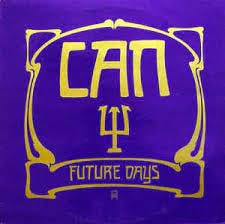This fan-recorded marvel hails from a different musical epoch, a time when a 35-minute entirely improvised exploration was not some terribly exotic thing. In 1975, people said yes to it. They wanted to take that ride.
Part of a projected series of previously unreleased Can performances, the five-section Stuttgart concert appears at an interesting moment: Today, most working musicians understand that the limit of audience attention sits somewhere between 30 seconds and two minutes – or the second iteration of a song’s chorus, whichever comes first.
The imperative to cut to the chase is ingrained now, an expectation that’s become such a consensus view it goes largely unstated. The idea of devoting a chunk of time to listening (not watching!) a group of musicians as they furtively paw their way into the unknown at considerable length seems, somehow, a Big Ask. Even though it wasn’t a thing at all in 1975, when Can was refining the outer edges of Krautrock. Or in November 1961, when John Coltrane tore out at the Village Vanguard, on a tune called “Chasin’ The Trane” for 16 minutes – a performance that accelerated the development of free jazz.
To appreciate music like this, don’t look for shortcuts: There is no highlight reel for Can’s Stuttgart 1975. It resists summation, possibly even defies play-by-play description. In the weeks since it surfaced, no doubt some enterprising scribe mapped out the peaks and valleys on a graph, to show precisely when the musicians converged around a common riff and when they peeled off to pursue their own ideas. I’d argue that’s largely a waste: The lure of it, the reward of it, is the chance to follow Can’s idea cultivation as it unfolds over time. No matter how long it takes. Even when it involves stretches of repetition, and those moments of diffuse wandering that are familiar to any follower of modern jam bands.
Those passages might seem tedious to TikTok ears. They’re nonetheless part of the ride – moments of repose that help frame the arc of the exploration, and help the musicians return to a blank-slate state so that a new conversation can begin. At that time, Can was attuned to this ebb and flow. Though the band’s then-current sixth studio album, Landed, contains crisp, tightly choreographed (if not quite pop) songs, in performance it preferred a more fluid electric-Miles atmosphere. Stuttgart 1975 features the original quartet — Irmin Schmidt on keys, Jaki Leibezeit on drums, Michel Karoli on guitar, and Holger Czukay on bass, with vocalist Domo Suzuki having departed in 1973 – showing up for work with no set list and no flight plan. Melodies and trace rhythmic elements from previous Can albums (like the classic Tago Mago and the astonishingly textured Future Days) flicker to the forefront and then disappear. At times the musicians reject those ideas outright, and in other moments they use them as fuel – reframing them while lurching into feral distorted guitar chords or a theatrically exaggerated double-time march.
In an excellent New York Times piece a few weeks ago, Schmidt (who helped prepare the cassette source recordings for release) described the conversational ethos that prevailed onstage during this period in Can’s evolution, which many regard as a peak. “It was sometimes sort of like a game. You threw something towards the other, and he picked it up, or he didn’t use it and threw it to somebody else. When it worked it was very beautiful and inspiring, even very amusing, using parts of what you have already done, but giving it a totally new direction.”
Can typically performed two extended sets with an intermission. The Stuttgart 1975 document begins with a 20-minute journey, followed by a 13-minute one, followed by an epic 36-minute excursion that’s notable for its high-contrast whiplash-inducing changes of mood and intensity. It also shows the band returning to similar tactics of rhythmic displacement and syncopation over and over again. That’s not automatically a negative thing – as I listened the second and third time to this, I came to appreciate those devices as providing a bit of “glue,” helping the musicians of Can in their pursuit of a long, not necessarily obvious, arc. To do that they needed big ears, and patience, and trust, and open lines of communication.
All of those qualities are on display here — just not all in the first minute. To encounter them, you have to take the ride.
Why yes, we have a fancy digital suggestion box. Share your favorite Underloved/Overlooked records here: echolocatormusic@gmail.com.
Please consider subscribing (it’s free!). And…..please spread the word! (This only works via word of mouth!)








It's Damo, not Domo.